Clinical Center News
President Barack Obama speaks at the Clinical Center
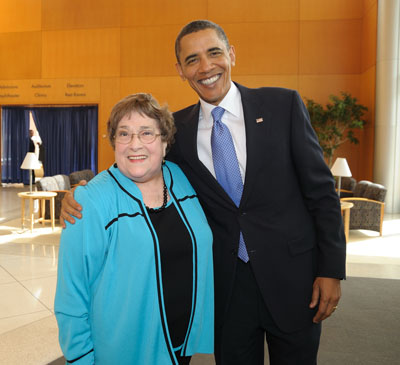 |
One of the first faces President Barack Obama saw upon entering the Clinical Center on September 30 was that of Susan Butler, longtime CC patient.
|
“Welcome to the House of Hope,” said Susan Butler, a long-time Clinical Center patient and 14-year survivor of simultaneous breast and ovarian cancer, in welcoming President Barack Obama here Sept. 30.
Obama traveled with Department of Health and Human Services Secretary Kathleen Sebelius to speak to the NIH community on The American Recovery and Reinvestment Act. “Today we’re announcing that we’ve awarded $5 billion—that’s with a “b”—in grants through the Recovery Act to conduct cutting-edge research all across America, to unlock treatments to diseases that have long plagued humanity, to save and enrich the lives of people all over the world. This represents the single largest boost to biomedical research in history,” Obama said.
Funds went to expand the Cancer Genome Atlas, “to make strides in the treatment and prevention of heart disease,” and to study autism, the president said.
Obama closed with a word to NIH intramural and extramural researchers: “The American people are looking forward to the next set of discoveries that all of you are working on today.”
Watch a videocast of his speech or read a transcript at http://whitehouse.gov.
Back to Top
CC epidemiologist named 2009 Distinguished Teacher
|
Dr. Tara Palmore, deputy hospital epidemiologist at the Clinical Center and associate director of the National Institute of Allergy and Infectious Diseases Infectious Diseases clinical fellowship in infectious diseases, was presented the NIH 2009 Distinguished Clinical Teacher Award on September 9.
|
Dr. Grace Chen, co-chair of the CC’s Clinical Fellows Committee, made the presentation before the first 2009 CC Grand Rounds Great Teachers lecture, reading from her peers’ nominations of Palmore: “One of the finest teachers I have had the pleasure of learning from … A mentor that clearly demonstrates a passion for teaching … A mentor whose clear respect and passion for patient care is only one of the many things I have had the pleasure of observing.”
 |
Dr. Tara Palmore (middle) will give the Seventh Annual Johns Laws Decker Memoral Lecture next year as 2009 Distinguished Clinical Teacher. She was presented with the award on September 9 by CC Director Dr. John I. Gallin and co-chair of the Clinical Fellows Committee, Dr. Grace Chen.
|
For her part, Palmore expressed surprise at being chosen.
“I was very pleased and surprised to be nominated. I was totally shocked when I won the award because in my opinion there were a number of other seasoned, experienced, and superb teachers among those who were nominated,” she said.
Palmore received her medical degree at the University of Virginia School of Medicine, completed residency training in internal medicine at New York-Presbyterian/Weill Cornell Medical Center, and came to the NIH in 2001 as an infectious disease fellow. She joined the NIH staff in 2005 and became deputy hospital epidemiologist in 2007. In this role, Palmore directs the development, organization, and implementation of the hospital infection control program.
The Distinguished Clinical Teacher Award has been presented each year since 1985 to an NIH faculty member who exemplifies the ideal qualities of a mentor, teacher, clinician, and researcher. The recipient delivers the annual John Laws Decker Memorial Lecture the following summer.
“We thank all of our staff for helping to train the next generation of distinguished clinicians,” said Dr. John I. Gallin, who opened the proceedings.
Also nominated this year were: Dr. Jose Apud, Dr. Juan Gea Banacloche, Dr. Theo Heller, Dr. John Tisdale, and Dr. Maria Turner.
Back to Top
Cancer-research advocating survivors cycle to the Clinical Center
By: Nicole Martino
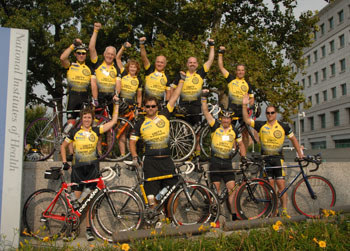 |
Members of Cyclists Combating Cancer, a small slice of Lance Armstrong’s LIVESTRONG army, posed outside of Natcher Auditorium, where they stopped last month as part of their nationwide bicycle tour to raise awareness about the need for cancer research funding.
|
A team of 12 cyclists biking across the country made a stop at the Clinical Center in September on their way to Capitol Hill to advocate for federal support of cancer research.
The riders—all cancer survivors and members of Cyclists Combating Cancer—rode in each clad in a bright yellow jersey with the Lance Armstrong Foundations’ tagline—“unity is strength, knowledge is power, attitude is everything”—emblazoned on the front.
“We are survivors, but we do not think of this as an appropriate term for us,” said Cindy Hart, the group’s director. “We would much rather be referred to as cancer warriors.”
Their NIH visit was the final stop on their Spokes of Hope tour, stopping at cancer care centers across the country to raise awareness about the need for funding for cancer research. Throughout the course of their journey the cyclists invited those who have been affected by cancer to sign a banner that they planned to deliver to legislators in Washington, DC.
“How many of these cancers are preventable? How many are detectable long before they became deadly, and how many of them could have been treated had we had the right weapons?” Hart asked.
After cycling to the Natcher Auditorium, the group heard presentations from National Cancer Institute staff members Shannon Bell, director of the NCI Office of Advocacy Relations; Susan Erickson, director of the NCI Office of Government and Congressional Relations; and Dr. Julia Rowland, director of the NCI Office of Cancer Survivorship. The team then received a tour of the CC.
“We have to listen to what survivors are telling us,” said Rowland. “We thank you for your time and willingness to share your stories because it makes an enormous difference.”
 |
Cindi Hart, Cyclists Combating Cancer director, adds names to the banner of people who have been affected by cancer the Spokes of Hope riders have encountered on their nationwide journey.
|
According to Cycling Combating Cancer’s Web site, members range from young to old, and from recreational road riders to racers and triathletes. The cyclists also represent a wide range of cancer diagnosis from the fairly common to rare forms. The group exists mainly as an e-mail listserve—connecting cancer survivors, family members of cancer victims, and caregivers with a passion for cycling.
The massive cardboard LIVESTRONG bracelet that traveled with the cyclists spoke to the group’s inspiration source: Lance Armstrong, who overcame testicular cancer and went on to win the Tour de France seven times. Cyclists Combating Cancer was recently honored by the Lance Armstrong Foundation with a conference room named after the group in recognition of their support, dedication, and the $1.3 million they have raised for the foundation since 2005.
“We look forward to getting smarter and even more effective in our battle. Thank you NCI and NIH for all that you have done and for continuing to do this on a daily basis, helping us win our war against cancer,” Hart said.
Back to Top
CC researchers develop new consent for cancer trials
By: Nicole Martino
About a third of NIH onsite clinical trials are Phase I studies—those that evaluate a new drug or treatment’s safety, determine a safe dosage range, and identify side effects. A team including Dr. Christine Grady, acting head of the Clinical Center Department of Bioethics, recently developed a shorter and simpler consent form for patients participating in Phase I oncology trials.
“Participants need to know that research is different than the regular care that they might be receiving elsewhere. Individuals need to know why it is being done, what it entails, and what the risks and benefits are,” Grady said.
The new consent template was published in the July-August issue of IRB: Ethics & Human Research. In addition to Grady, the research team included Dr. Shlomo Koyfman from the Department of Radiation at the Cleveland Clinic; Mary S. McCabe, director of the Cancer Survivorship Program at Memorial Sloan Kettering Cancer Center; and Dr. Ezekiel Emanuel, chief of the CC Department of Bioethics and on detail as special advisor for health in the White House Office of Management and Budget.
The idea to create a simplified consent form grew out of a study by the CC Department of Bioethics several years ago that collected Phase I oncology trial consent forms from around the country to analyze content. That study team found that some of the consent forms were different and easier to understand than others.
The informed consent process is especially important for individuals enrolled in Phase I oncology trials because of the nature of the trial and the nature of the individuals, Grady said. “Phase I research is controversial because it is done to determine safety and toxicity, yet it involves people who are sick, who have advanced cancer and have exhausted usually all available treatments for their cancer. So there is this confluence of potentially vulnerable people with a study that is designed for purposes that are not to benefit them. You want to be sure that people understand that.”
After reviewing more than 200 consent forms for Phase I oncology trials, the CC, Cleveland Clinic, and Sloan Kettering team created the improved consent template in both English and Spanish by redesigning and rewording it to be specific to Phase I trials and to avoid repetition and utilize simplified language. The new form is divided into identifiable sections framed by first-person questions and presents statistical information in tables. It is also about two pages shorter than the average consent form.
Since its publication this summer, the form has been available to investigators who wish to use it, available on the IRB: Ethics & Human Research Web site. Grady plans to put the consent form on the CC’s Web site for access and easy adaptation.
Researchers are currently developing a randomized controlled trial to test the new consent form against a standard template to compare and evaluate patients’ understanding and satisfaction.
Back to Top
Former pharmacy chief receives Career Achievement Award
 |
Dr. Joseph Gallelli
|
At the US Public Health Service (PHS) Commissioned Officers Administration meeting in Atlanta in June, Dr. Joseph Gallelli, Clinical Center senior advisor for biotechnology product development and former chief of the Pharmacy Department, received the 2009 George F. Archambault PHS Career Achievement Award in Pharmacy.
This high honor recognizes a PHS member who has made outstanding achievements in or contributions to the pharmacy profession.
Gallelli was cited for his sustained outstanding career accomplishments and contributions to the pharmacy profession in his more than 40 years at the NIH.
In his acceptance speech Gallelli said what made the Career Achievement Award extra special for him was that it was associated with Archambault, a man he knew and respected. Archambault was the first pharmacy liaison officer for the PHS.
“I first met Dr. Archambault when he came to Temple University School of Pharmacy to speak to the students about a career in the USPHS,” Gallelli remembered. “I was most impressed in seeing this man, dressed in a PHS uniform, talk about the different roles pharmacists can have in the US Public Health Service. He was mesmerizing, articulate, and dynamic.
“All of us who had careers within the PHS owe a debt of gratitude to Dr. Archambault. He certainly was the major force that lead and directed the growth of this program and made it what it is today.”
Back to Top
Former patient’s art explores inner and outer landscape
The most recent addition to the Clinical Center’s permanent art collection—a program to enhance the patient experience—comes from one of the target audience.
River Cells is an oil painting by former patient Paula Crawford, an associate professor of painting at George Mason University who has exhibited nationally and internationally.
“I’ve been an artist most of my adult life,” Crawford said. “That is what I’ve gotten up in the morning to do everyday.”
 |
River Cells © by Paula Crawford
|
Some of those days were spent in the CC to participate in a protocol under Dr. Yaron Rotman from the Liver Diseases Branch of the National Institute of Diabetes and Digestive and Kidney Diseases for treatment of chronic Hepatitis C. Crawford cited a contaminated gamma globulin shot received before a trip to Mexico as the probable source of her infection.
Despite the taxing treatment regime, Crawford said, “I had the best medical care that I have ever experienced in my life … Everywhere at the Clinical Center—the liver clinic, phlebotomy, and elsewhere—I encountered a rare and unparalleled combination of organization, competence, and kindness.”
While around the building, her artist’s eye noticed the aesthetics. “The care to the physical building coupled with that of the doctors and staff become critical to a kind of total experience the patient receives.”
To add to the CC’s collection, Crawford painted River Cells in a few months. “I was trying to make a painting that both felt like watching river stones beneath rushing water (outside landscape), but also somewhat like looking through a microscope (interior landscape),” she said. The piece will hang in the Hatfield Building’s seventh floor breezeway.
“I hope that the art work inspires patients and co-workers the way Paula’s courage and determination inspired me,” Rotman said.
Back to Top
Education office new addition named Intern of the Year
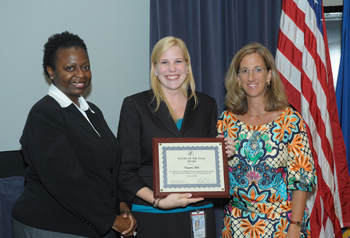 |
Virginia Hill (center) recent graduate of the Presidential Management Fellows program, accepted the Intern of the Year award from PMF program manager Cheronn Collins (left) and CC Chief Operating Officer Maureen Gormley at the Administrative Internship Awards in late August.
|
A recent addition to the Clinical Center, Virginia Hill is already racking up awards. A graduate of the Presidential Management Fellows (PMF) program, Hill joined the CC as special assistant for educational affairs and strategic partnerships in the Office of Clinical Research Training and Medical Education (OCRTME) in August 2009.
At the Administrative Internship Awards ceremony on August 27, CC Chief Operating Officer and past chair of the Administrative Training Committee Maureen Gormley announced Hill as Intern of the Year, nominated by coworkers and supervisors. Hill also received a Peer Recognition award.
The PMF program—sponsored by the US Office of Personnel Management—attracts men and women from a variety of academic disciplines who have a clear interest in the leadership and management of public policies and programs. The two-year NIH PMF program is coordinated by the NIH Training Center. Fellows complete three-to-six-month rotations at institutes and centers of their choosing and one rotation at an outside institution, before settling into a “permanent” position.
Hill entered the PMF program after two years as a clinical social worker in Baton Rouge, La., during the wake of Hurricane Katrina, strengthening her commitment and passion for helping others. She earned a Master of Social Work from Louisiana State University in May 2007, and accepted an NIH management fellowship later that summer. Hill’s rotations focused on communications and public affairs to disseminate in creative ways the important biomedical research of the NIH.
“I have a passion for working with the public and making sure the government is working for the people,” Hill said.
In her new role with the OCRTME, Hill’s major responsibilities relate to communication of various training programs that the CC offers. She has already helped to launch the new Sabbatical in Clinical Research Management program and is working on upgrades and additions to the office’s Web site.
Dr. Frederick Ognibene, director of the OCRTME, states, “Ginny’s enthusiasm and expertise in communications and new media will allow a number of initiatives to expand greatly, reaching a broad audience on campus as well as partners in the extramural community. She will be an asset to the Clinical Center’s and NIH’s mission.”
Back to Top
Seasonal flu vaccine clinic begins, a must for patient-care staff
The NIH employee seasonal flu vaccine clinic will kick off Monday, October 19. All staff with a valid NIH employee (non-contractor) identification badge will be provided the seasonal flu vaccine free of charge on the seventh floor of the Hatfield Building or at one of the listed off-site locations.
Vaccinations will be given based on the first letter of employees’ last names. Those who show up on the wrong day will be vaccinated, but can expect a longer wait. Please dress appropriately in clothing that will let you quickly expose your upper arm; changing areas will not be available.
The seasonal flu vaccine is mandatory for patient-care staff. New this year, contractors are included in this special group. Those who are unwilling or unable to be vaccinated due to medical contraindications or religious or philosophical objections must sign a declination form explaining the reason. Declination forms can be signed at the vaccine clinic or at the Occupational Medical Service.
Patient-care staff will also be required to be vaccinated against novel H1N1 influenza. The nH1N1 vaccine should become available later in the fall. The quantity of the vaccine obtained by NIH will determine if it can be made available to all staff.
The seasonal influenza vaccination schedule and more information on the patient-care staff mandate and the nH1N1 vaccine can be found at http://foiltheflu.nih.gov.
|
CRC, 7th floor atrium east side
First letter, last name
|
Date
|
AM
|
PM
|
|
EFGH
|
10/19
|
8-11
|
1-3:30
|
|
TUVWXYZ
|
10/20
|
8-11
|
1-3:30
|
|
NOPQRS
|
10/21
|
8-11
|
1-3:30
|
|
ABCD
|
10/22
|
8-11
|
1-3:30
|
|
IJKLM
|
10/23
|
8-11
|
1-3:30
|
|
IJKLM
|
11/02
|
8-11
|
1-3:30
|
|
NOPQRS
|
11/03
|
8-11
|
1-3:30
|
|
ABCD
|
11/04
|
8-11
|
1-3:30
|
|
TUVWXYZ
|
11/05
|
8-11
|
1-3:30
|
|
EFGH
|
11/06
|
8-11
|
1-3:30
|
|
Off-site locations
|
Date
|
AM
|
PM
|
|
Twinbrook 3
12735 TB Pkwy
Room 2E06
|
10/26
|
8:30-11
|
1-3
|
|
Rockledge I
6705 Rockledge Dr
Room 5054
|
10/27
&
10/28
|
8:30-11
|
1-3
|
|
Executive Plaza North
6130 Executive Blvd
Room 103
|
10/29
&
10/30
|
8:30-11
|
1-3
|
|
Neuroscience Center
6001 Executive Blvd
TBA
|
11/09
|
8:30-11
|
1-3
|
|
Poolesville
|
11/10
|
8:30-11
|
1-3
|
|
Walk-in clinic
OMS Bldg 10/Rm 6C306
|
Date
|
AM
|
PM
|
|
Open to all NIH employees
|
11/09 - 11/13
|
7:30-11
|
1-3:30
|
Back to Top
Radiology and Imaging Sciences honors staff service
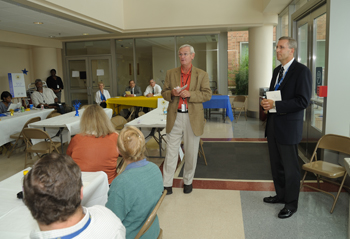 |
CC Deputy Director for Clinical Care Dr. David Henderson (left) and Radiology and Imaging Sciences Director Dr. David Bluemke thanked those gathered for their years of dedication and service.
|
Clinical Center Radiology and Imaging Sciences celebrated the accomplishments and dedication of itsemployees with an annual service award ceremony on September 16.
“This is something that everybody here is really deserving of,” said Dr. David Bluemke, Radiology and Imaging Sciences director. “We have people who have devoted a large part of their lives to the NIH and to the United States government.”
In the opening remarks, Dr. Ronald Neumann, director of Nuclear Medicine, told the story of when he first came to the NIH to interview for a job at the CC. He was impressed by the technology and the resources. Yet later that day—on an airport-bound shuttle—he overheard several patients commenting about the care they had received at the NIH, and it was those comments, not the technology, that persuaded him to join the CC team.
“I don’t think people come here because we have new nuclear medicine scanners. Rather, people come here for the interaction with all of you,” Neumann told the staff.
Back to Top
Session promotes partnerships with vet-owned businesses
By: Nicole Martino
The Clinical Center Office of Purchasing and Contracts hosted an outreach session in August to encourage CC partnerships with service-disabled veteran-owned small businesses—“Partnering for Success with the NIH Clinical Center.”
“We have a really dedicated and caring team of professionals in the Clinical Center,” Maureen Gormley, CC chief operating officer, said, welcoming the group. “One of the reasons that we wanted to put this forum on today is so that you could get to know us and we could get to know you.”
Session attendees received advice on forming relationships with a large federal institution like NIH from Annette Owens-Scarboro, small business specialist to NIH from the DHHS Office of Small and Disadvantaged Business Utilization.
“This was an opportunity to demonstrate our commitment to go that extra mile to expand small business opportunities and to provide vendors additional information that may be useful in their efforts to obtain contract awards to provide supplies and services to the Clinical Center,” said Janice Brunson, deputy director of the CC Office of Purchasing and Contracts.
The vendors and small business owners heard from a list of speakers representing several CC departments and offices: the Department of Transfusion Medicine, the Department of Anesthesia and Surgical Services, the Medical Record Department, the Office of Protocol Services, the Department of Bioethics, the Office of Credential Services, the Office of Organizational Development, Radiology and Imaging Sciences, and the Department of Clinical Research Informatics. Each representative detailed their responsibilities within the CC and described workforce and purchasing needs. Attendees were given the opportunity to speak with department heads at a meet-and-greet session after the forum.
“We pride ourselves on being real people; we are different than a big office-building-type setting,” Gormley said. “We are looking forward to establishing relationships that, down the road, can be mutually beneficial. “
Back to Top
Bedside-to-Bench Award program taking submissions
The NIH Bedside-to-Bench program is welcoming proposals for the next funding cycle. Up to $135,000 per year for two years will be available to support selected intramural and extramural partnerships in clinical research.
Extramural principal investigators with an existing NIH grant can submit a proposal by linking up with an intramural collaborator at NIH who would serve as project leader and point of contact. A list of current intramural research at NIH is online at http://intramural.nih.gov/search/index.html. Most awardees involve projects bringing patients to the intramural program at the Clinical Center.
Research proposals can fall into one of seven categories: Pharmacogenomics, Behavioral and Social Sciences, Rare Diseases, HIV/AIDS, Minority Health and Health Disparities, Women’s Health, or General Projects.
For awards involving extramural partners, extramural funds will be applied as an administrative supplement to an existing grant. If need be, the amount of funds could be increased to cover indirect costs. Projects must be eligible to receive administrative supplements for two years, and the support would need to be in line with the approved aims and objectives of the original grant. Investigators for awarded projects will be required to submit annual progress reports and status updates.
The Bedside-to-Bench program uses an electronic venue called “proposalCentral” to help investigators submit a letter of intent and collaborate online with the project leader while developing a proposal for submission.
Letters of intent must be submitted by Oct. 22, 2009. For more information, log on to http://www.cc.nih.gov/ccc/btb/awards.shtml.
The Bedside-to-Bench program was established in 1999 to integrate the work of basic and clinical intramural scientists. Since 2006, it has been open to partnerships between intramural and extramural projects.
Back to Top
BTRIS lead demonstrates new system
The clinical researcher at NIH has a new best friend, and her name is BTRIS.
The NIH Biomedical Translational Research Information System was the subject of a town hall meeting September 15 as Dr. Jim Cimino, chief of the Clinical Center’s Laboratory for Informatics Development, put the system through its paces to demonstrate its capabilities.
“Everyone is generating data like crazy all over the place,” Cimino said. “The idea is to take all these data and put them into a single database with some standards for access and techniques for internal retrieval.
The new system—launched July 30—contains data from the CC’s Clinical Research Information System (CRIS) going back to 1976 and data from older systems all the way back to 1962. BTRIS currently contains 112 million rows of data and adds about a million rows each week, Cimino said.
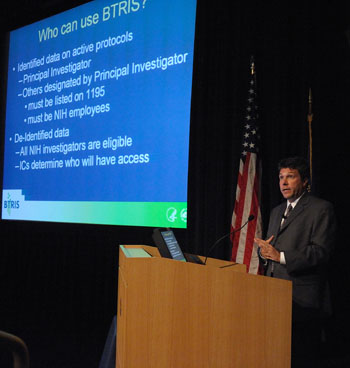 |
Dr. Jim Cimino, chief of the Laboratory for Informatics Development, took BTRIS for a spin at a meeting last month, breaking down who and how one can use the system.
|
BTRIS is two distinct but interrelated applications, BTRIS Preferences allows principal investigators (PI) to verify subject enrollment in their protocols, assuring that BTRIS reports contain accurate and complete data. Preferences also allows PIs to select designees to assist with protocol attribution or to run queries.
The second arm, BTRIS Data Access, offers identified data on active protocols—“the meat of it,” Cimino said—to those protocols’ PIs and designees. Researchers can run summary (IRB enrollment) or subject data (demographics, vitals, lab results, etc.) reports with ease thanks to BTRIS’ word search or tree navigation. The results can be exported in various file formats, such as Microsoft Excel, and downloaded for further analysis.
Phase II of BTRIS will allow all NIH investigators (subject to institute or center approval) access to de-identified data. This will encourage researchers to generate new hypotheses, increase subject sample size for proposed protocols, and find potential collaborators, Cimino said.
Users must complete an automated Office of Human Subjects Research form in BTRIS to access de-identified data, stating their research question and how they will use the data. When a de-identified query contains data from active protocols and from protocols terminated less than five years ago, use of these data must be cleared with the PI.
Cimino wrapped his town hall meeting with his hopes for the future of BTRIS: finish gathering historical data, implement BTRIS as a
Web service, and add new reports and navigation techniques.
The CC, the National Institute for Allergy and Infectious Diseases, and the National Institute for Alcoholism and Alcohol Abuse currently contribute data to BTRIS. The National Cancer Institute and CC Radiology and Imaging Sciences will join in the coming months.
Dr. Michael Gottesman, NIH deputy director for intramural research, introduced Cimino at the September 15 meeting. “I encourage anyone who does clinical research to explore BTRIS,” he said.
The town hall session is online at http://btris.nih.gov.
Back to Top
News Briefs
Researchers’ role in community engagement
The Staff Training in Extramural Programs committee will hold a forum—The Nuts-and-Bolts of Community Engagement in Research—on October 28 in Masur Auditorium.
This free training will introduce five core principles of community-engaged research through presentations emphasizing methodology, theoretical frameworks, and evaluation techniques used in effective community engagement approaches. Presenters will also discuss communication and facilitation skills used to develop connections and build relationships with communities. NIH Principal Deputy Director Dr. Raynard Kington will make the opening remarks for the Nuts-and-Bolts forum, which was inspired by recommendations from the NIH Director’s Council of Public Representatives.
Held 9:00 am to 12:30 pm, the event is open to all NIH staff. No registration is required. Visit www.copr.nih.gov/STEP for more information.
Former patient sibling accepts donation
Olivia Tomoff, 17, center, accepted a donation to SuperSibs presented by Jon Belinkie from the Rock and Roll for Children Foundation on September 9 at The Children’s Inn. Tomoff, whose brother is a cancer survivor, has received years of support from SuperSibs. Dr. Lori Wiener, coordinator of the National Cancer Institute’s Pediatric Psychosocial Support Program, attended as an NIH representative. Supersibs supports the siblings of NIH patients, as well as provides guidance and materials for the NIH Sibling Day. Belinkie also presented Tomoff with a drumhead signed by rockers who played at his foundation’s recent fundraiser. “We’re happy to do it,” Belinkie said of the Supersibs donation. “Hopefully it’s the first of many.”
Winter meetings highlight critical care
Experts on critical injury and illness will gather for discussion and research sharing at two events held in the Natcher Conference Center in December.
The Seventh Symposium on the Functional Genomics of Critical Illness & Injury on December 7 is sponsored by the National Institute of General Medical Sciences, the Clinical Center Critical Care Medicine Department, and the NIH Scientific Interest Group on Critical Illness and Injury. Washington University in St. Louis School of Medicine is co-sponsor. The call for abstracts closes October 31, and registration ends November 6.
The two days after the symposium, NIGMS and the NIH Scientific Interest Group on Critical Illness and Injury will hold the Annual Fall Meeting of the US Critical Illness and Injury Trials Group. Washington University in St. Louis School of Medicine will also co-sponsor this event on December 8 and 9. Registration closes November 6.
For more information on both meetings and to register, visit http://fgciitg.com.
Pain in the neck?!
If you are a healthy individual older than 21 years of age who has been experiencing neck pain for three months or less, you may be eligible to participate in a neck pain study and receive a comprehensive cervical musculoskeltal examination. This is not a treatment study. For more information, e-mail neckpainstudy@gmail.com or call 301-451-7514.
Staff trained in barcoding id system
Outpatient Phlebotomy staff, including Michael Guyah (above), were trained last month to collect clinical and research specimens using a new barcode technology system. This technology enhances patient safety by supporting the accurate identification of Clinical Center patients and the printing of specimen labels at the point-of-care. Inclusion of the new system in outpatient specimen collection is phase II of the barcode go-live. During Phase III, barcode technology will be introduced in the inpatient, outpatient, and day hospital settings. Phase IV adds the barcode process to blood and blood component transfusions. Learn more about the implementation and project goals in the archived September 2009 issue of CC News online at http://www.cc.nih.gov/about/news/newsletter.html.
The Clinical Center Rehabilitation Medicine Department’s NIH Relay team—Pushing Our Gluteus to the Maximus—placed 10th out of 105 teams on September 17. The five-person team (each runner covered a half mile) finished in 15:42. Above, Abrahm Behnam (right), and William Sipprell warm up on their way to the starting line. Also on the team were Mellissa Luhmann, Laura Maring, and Dr. Hyung Park.
OP-12 clinic move
As part of the clinic realignment multi-year project, in addition to the general spruce-up of all the clinics, some of the outpatient clinics have undergone some major improvements that required construction work. During this construction period, the OP-13 clinic programs (National Cancer Institute medical oncology and NCI dermatology) were relocated to 2J and the OP-12 clinic programs (NCI medical oncology, NCI neuro-oncology, and National Institute of Neurological Disorders and Stroke neurosurgery) were relocated to OP-13.
The OP-12 clinic construction project has finally been completed and the medical oncology program has moved back to OP-12. The neuro-oncology clinic will remain on OP-13 permanently and will resume clinic on Wednesdays and Fridays. The NCI medical oncology and NCI dermatology programs will move back to OP-13 later this month.
“This part of the clinic realignment project could not have been accomplished without all of the time, work, and flexibility provided by the employees from the various Clinical Center departments and the NCI leadership, physicians, nurses, and administrative staff involved. I want to personally thank everyone involved,” said Karen Kaczorowski, deputy chief nurse officer.
We would like to hear from you!
The NIH Office of Communication and Public Liaison and the NIH Director’s Council of Public Representatives have partnered to develop a consumer-health-information request for information in response to a directive by President Barack Obama to all federal agencies calling for greater transparency, public participation, and collaboration.
Information gathered will assist the agency in developing and disseminating health, medical, and scientific information to a broad audience.
The request for information may be completed online in English or downloaded from the Web site in Spanish. For more information please visit http://nihhealthinfoRFI.nih.gov.
Back to Top
Upcoming Events
October 14
CC Grand Rounds
Lipsett Amphitheater, 12 pm
Contemporary Clinical Medicine: Great Teachers
The Sea Within Us: Clinical Disorders of Water Homeostasis
Robert W. Schrier, MD
Professor of Medicine, Division of Renal Diseases and Hypertension
University of Colorado Denver, School of Medicine
Wednesday Afternoon Lecture Series
Masur Auditorium, 3 pm
Gridlock on the Genomic Beltway: How Epigenetic Gene Silencing Shapes our Cellular Phenotypes
Frank J. Rauscher, III, PhD
Deputy Director for Basic Science, Wistar Institute Cancer Center
October 21
CC Grand Rounds
Lipsett Amphitheater, 12 pm
Ethics Rounds
The Ethics of Using Lotteries as Incentives for Clinical Research
Tyler Cowan, PhD
Professor of Economics, George Mason University
Wednesday Afternoon Lecture Series
Masur Auditorium, 3 pm
Intra- and Inter-Species Cell-to-Cell Communication in Bacteria
Bonnie Bassler, PhD
Squibb Professor of Molecular Biology, Princeton University
investigator, Howard Hughes Medical Institute
October 28
CC Grand Rounds
Lipsett Amphitheater, 12 pm
Novel Treatment for Myelodysplasia
Elaine M. Sloand, MD
Senior Investigator, Hematology Branch, NHLBI
Matthew Olnes, MD, PhD
Clinical Fellow, Hematology Branch, NHLBI
Staff Clinician, Center for Human Immunology and Inflammation (CHI)
Wednesday Afternoon Lecture Series
Masur Auditorium, 3 pm
Stress and Health: From Molecules to Socities
Robert Sapolsky, PhD
Professor of Biology, Neurology and Neurosurgery, Stanford University
Back to Top
This page last updated on 12/14/2017


 The information on this page is archived and provided for reference purposes only.
The information on this page is archived and provided for reference purposes only.